- Climate
Data shows temperatures rising in Greenland and around the world; current global warming is driven by CO2, not solar activity
Key takeaway
The effect of atmospheric CO2 concentrations on global temperatures is well established; as concentrations rise, global warming increases through the greenhouse effect. Scientific studies show that modern global warming is primarily driven by increasing CO2 emissions from human activities. Based on the available scientific evidence, solar variation has had no significant effect on modern global warming compared to rising atmospheric CO2 concentrations.
Reviewed content
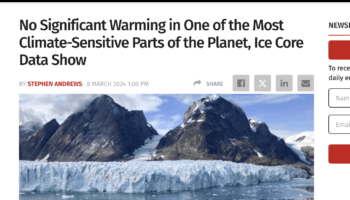
Verdict:
Claim:
Ice cores from Greenland show no significant warming, casting doubt on the climate change theory
Verdict detail
Factually inaccurate
The claim that there is no global warming signal from Greenland is in direct contradiction with available observations. Recent studies of ice cores from several locations in Greenland have shown that temperatures are warming faster than the natural variation of the last 1000 years. Rising temperatures in Greenland do not necessarily represent global changes. However, other studies have shown evidence of rising temperatures around the world.
Unsupported
There is no evidence to support that solar cycle variation has a greater impact on rising global temperatures than increasing atmospheric CO2. In fact, solar intensity is currently declining while global temperatures are rising. Evidence shows that rising atmospheric CO2 from human activities is the primary driver of modern global warming.
Cherry-picking
Ice core data from one location in Greenland is insufficient to represent the entire planet. Numerous recent studies with larger data sets and rigorous statistical analysis show a global warming trend around the world.
Full Claim
Ice cores from Greenland show no significant warming, casting doubt on the climate change theory; above a certain concentration of carbon dioxide, it has minimal direct impact on global temperature relative to solar cycles.
The consensus among climate scientists is that modern global warming is primarily driven by increases in atmospheric CO2 from human activities[1]. A major component of studying global warming is comparing present conditions with those of the past. However, taken out of context, these data can be misinterpreted to draw conclusions that are inaccurate and unsupported.
A recent example is in an article on The Daily Sceptic, which made several claims about global warming using a small subset of the available climate data, which we will investigate below. Based on ice core data from one part of Greenland, the article claims that “there is no significant global warming signal coming from one of the most sensitive parts of the planet”, and that these data–which show a rising temperature trend in modern times–fall within a normal (natural) variation. However, this claim is in direct contradiction with scientific findings, mischaracterizes the cited data, and excludes sufficient context about how global warming trends are studied.
Evidence of Rising Temperatures in Greenland
Scientists use climate proxies, such as ice cores, to help them reconstruct past conditions. For example, stable water isotope (δ18O) signals from ice cores can be used to determine past local temperatures[2]. This method was employed in the studies referenced by The Daily Sceptic article. However, the article leaves out critical details about the uncertainties in the data and mischaracterizes the findings. One study the article references has proxy data from 10,000 BCE to 1960 CE; however, this period excludes several recent decades of available climate data. The second paper the article references, Holme et al. (2019), studied proxy data from 1801-2014, which, as the article correctly points out, shows a rising trend in the δ18O signal. However, the article excludes an important conclusion from the study: “the linear δ18O–temperature relationship was unstable with time which implied that the annual-to-decadal variability of δ18O measured in an ice core could not be directly attributed to temperature variability.”[3] Therefore, there is less certainty when using these data to assess Greenland temperature trends over recent decades.
There is a study, however, that analyzed recent temperature trends in Greenland compared to natural variation–the main topic of The Daily Sceptic article. Hörhold et al. (2023) analyzed ice core data from central and northern Greenland–a larger study area–to create a high-quality temperature reconstruction for the period of 1000-2011[4]. The study showed that “the warming in the recent reconstructed decade exceeds the range of the pre-industrial temperature variability in the past millennium with virtual certainty (P < 0.001)”[4] (Figure 1). The authors had greater confidence in these temperature trends due to the high correlation between the δ18O data and local temperature data–which was lacking in the Holme et al. (2019) study.
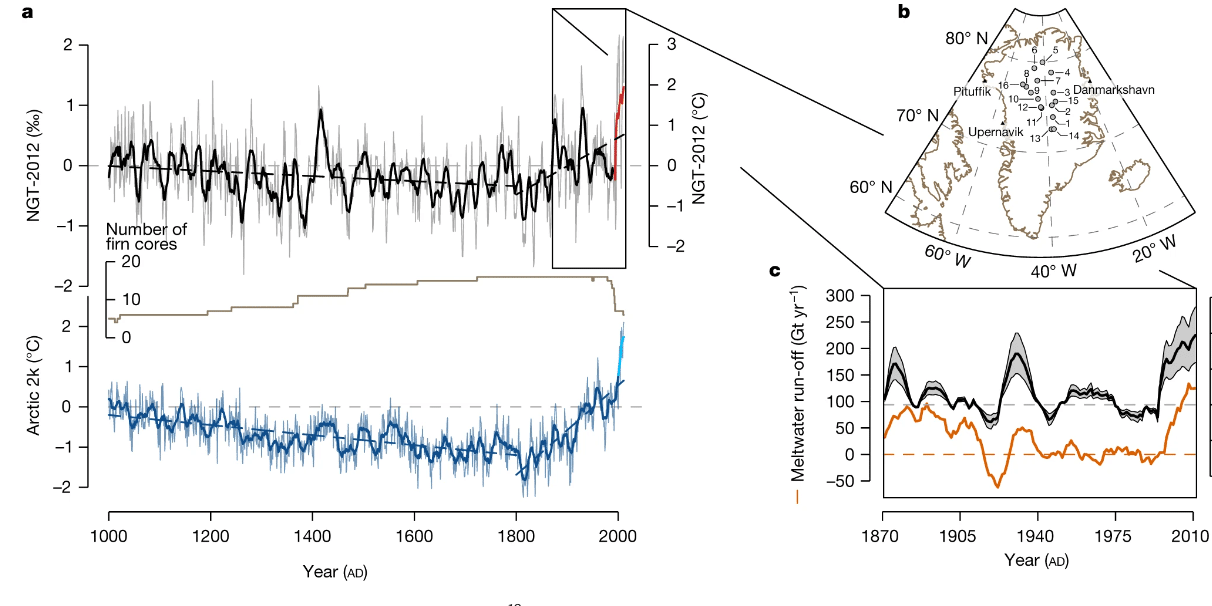
Based on these findings, the claim made in The Daily Sceptic article regarding a lack of global warming signal from Greenland is inaccurate and a mischaracterization of the supporting data. The Hörhold et al. (2023) study–which analyzed more ice core data (with greater spatial coverage) and achieved high data correlation–found clear evidence of warming in Greenland which exceeded the natural variation of the last 1000 years[4].
Evidence of Rising Global Temperatures
While proxy data from one location can be used to reconstruct past local temperatures, it is not necessarily sufficient to reconstruct past global temperatures. To explain this, Dr. Joanna Haigh, Emeritus Professor of atmospheric physics at Imperial College London, provided Science Feedback with the following comment about the article: “using one location to represent global warming is invalid. He [the author] refers to Greenland [as] being the most sensitive place without saying how that is defined. There is substantial evidence of larger variations in temperature at different locations [e.g. Dansgaard-Oescher events]. These are not fully understood but are not used to make statements on global parameters.” To better understand global climate change and reduce uncertainty in their studies, scientists use a variety of methods and analyze a greater number of samples.
The Daily Sceptic article only cites data from one area in Greenland; however, there are studies which used more proxies and methods to reduce uncertainty. For example, a study by Kaufman et al. (2020) used 679 proxy sites (Figure 2) and five different statistical methods when reconstructing global mean surface temperatures (GMST) for the last 12,000 years[5]. This multi-method approach helped the researchers create an ensemble of global temperature reconstructions that account for the uncertainties of the different methods. By increasing the number of samples and locations they analyze, researchers also have greater confidence that the results better represent global changes, rather than local changes.
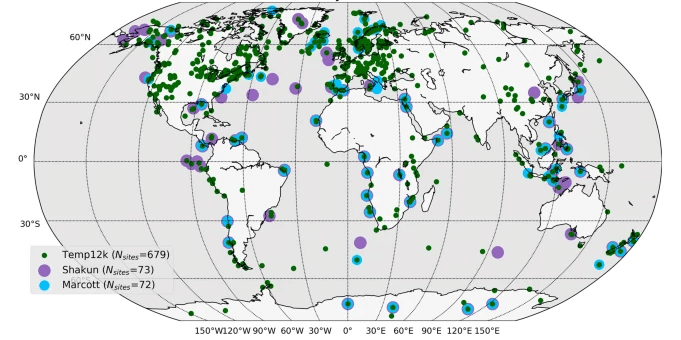
The Kaufman et al. (2020) study indicated that there were periods of cooling and fluctuation over the last 12,000 years (Holocene); however, it also showed a modern rise in global warming[5]. As the authors explain, “The distribution of peak global temperatures during the Holocene can also be compared with recent temperatures. The GMST of the past decade (2011–2019) averaged 1°C higher than 1850–1900. For 80% of the ensemble members, no 200-year interval during the past 12,000 years exceeded the warmth of the most recent decade.”[5] The results of this study (Figure 3) show that a rising global warming trend began in the industrial era and has continued to the present day.

Kaufman et al. (2020) explain that the comparisons they made between 200-year intervals of the Holocene and modern warming are conservative in the context of IPCC projections, which indicate that temperatures are likely to rise higher than 1°C above pre-industrial temperatures in the next century[5]. They then explain that the IPCC projections give a better comparison between warming in recent decades and the temperatures in the Holocene reconstructions.
A number of other studies have also shown evidence that modern global warming trends are unusual compared to past variations. According to The Intergovernmental Panel on Climate Change (IPCC), the world’s leading authority on climate science, the last 1000 years of temperature data and their methods of reconstruction have been well-studied[6]. One of the studies the IPCC refers to, PAGES 2K Consortium (2019), explains that “the largest warming trends at timescales of 20 years and longer occur during the second half of the twentieth century, highlighting the unusual character of the warming in recent decades.”[7]
Rising CO2 Has Driven Global Warming, Not Solar Cycle Variability
The Daily Sceptic article also claimed that a lack of global warming signal from the data he provided “could be explained by the fact that the relationship of carbon dioxide to global temperature is logarithmic and above a certain concentration there is minimal direct impact relative to solar cycles.” However, this claim is inconsistent with available evidence. In fact, Science Feedback has done several investigations of similar claims about solar influence on climate change, a sample of which are linked below:
- Review 1: The sun isn’t responsible for current climate change, contrary to claims in Suspicious0bservers YouTube video
- Review 2: Low solar activity has little effect on Earth’s climate, contrary to claim in The Sun
- Review 3: Claim that current climate change can be explained satisfactorily by natural cycles and volcanic activity does not have scientific support
These reviews provide several lines of evidence that solar activity is not driving the rise in global temperatures. For example, one review explains that if the Sun were driving global warming, we should see temperatures rising at the surface of the Earth and throughout the Earth’s atmosphere. Instead, the data show Earth’s surface heating up, while the layers of the atmosphere are changing variably–lower altitudes heating, and higher altitudes cooling[8]. Another review found that the rate and magnitude of modern global warming is too high to be caused by solar variations[9].
The physics of both solar cycle variation and atmospheric CO2 are well understood. The IPCC explained that solar activity from the late 19th century to present was not exceptional compared to the last 9,000 years[6]. The IPCC also compared observed temperature changes to models that accounted for both human and natural influences (Figure 4). As shown below, in both the observed data and simulated cases, the addition of human drivers–such as CO2 emissions–lead to a greater rise in global temperatures.
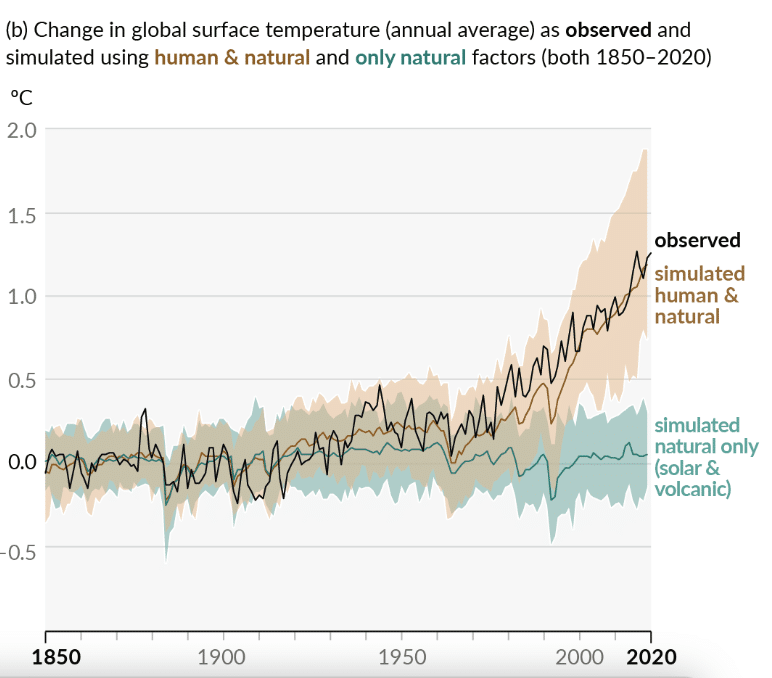
After reviewing the Daily Sceptic article’s claim about solar variability, Dr. Joanna Haigh provided the following comment: “He [the author] does not define ‘solar cycle’, normally used to refer to [the] 11-year activity cycle; he presumably means longer term solar activity which is currently declining so [it] can’t explain recent global warming.” And in response to the article’s claim of diminishing CO2 impacts, Dr. Haigh commented “Fig.6 in the paper [Zhong and Haigh (2013)] shows logarithmic response in radiative forcing of temperature to CO2 increase – but still rising. In that paper we used 389 ppm [parts per million] as [the] current CO2 concentration. It is now 425 ppm – higher than for millions of years and rising unremittingly.” Dr. Haigh’s explanation highlights that atmospheric CO2 concentration is increasing, and despite the response being logarithmic, global temperatures are, and will continue, rising with increasing CO2 (Figure 5).
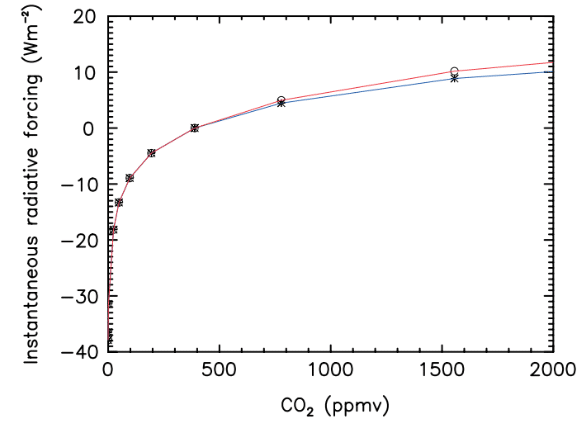
In other words, the study shows that radiative forcing–the effect of Earth’s atmosphere receiving more energy from solar radiation that it emits back out to space–lessens gradually with increasing CO2 concentrations, but remains positive[10]. The Zhong and Haigh (2013) paper concludes that as CO2 increases in the atmosphere, there is no saturation point at which it will no longer cause radiative forcing–therefore, it will continue to be a factor in global warming.
Conclusion
As shown above, the claims that the Daily Sceptic article made about Greenland temperature trends, global warming signals, CO2, and solar cycles are incorrect and unsupported. Scientific evidence on these subjects shows the following: temperatures in Greenland and around the world are rising, the primary driver is increasing atmospheric CO2 from human emissions, and solar variation has had no significant effect on rising modern global temperatures. Although the response is logarithmic, as CO2 concentrations increase, so will global temperatures. This is evident based on climate models and the physics of CO2, which are well understood. After analyzing and modeling the drivers of climate change, the IPCC found no evidence that solar variation can account for the rising trend of global temperatures. Several studies, which reviewed up to 10,000 years of climate proxy data, show that the current rate of global warming is unusual compared to past natural variations.
REFERENCES
- 1 – Anderegg et al. (2010) Expert credibility in climate change. Proceedings of the National Academy of Sciences.
- 2 – Markle and Steig (2022) Improving temperature reconstructions from ice-core water-isotope records. Climate of the Past.
- 3 – Holme et al. (2019) Varying regional δ18O–temperature relationship in high-resolution stable water isotopes from east Greenland. Climate of the Past.
- 4 – Hörhold et al. (2023) Modern temperatures in central–north Greenland warmest in past millennium. Nature.
- 5 – Kaufman et al. (2020) Holocene global mean surface temperature, a multi-method reconstruction approach. Nature.
- 6 – IPCC (2021). Sixth Assessment Report.
- 7 – PAGES 2K Consortium (2019) Consistent multidecadal variability in global temperature reconstructions and simulations over the Common Era. Nature Geoscience.
- 8 – Santer et al. (2013). Human and natural influences on the changing thermal structure of the atmosphere. Proceedings of the National Academy of Sciences.
- 9 – Pierce and Adams (2009) Can cosmic rays affect cloud condensation nuclei by altering new particle formation rates?. Geophysical Research Letters
- 10 – Zhong and Haigh (2013) The greenhouse effect and carbon dioxide. Royal Meteorological Society Weather.
Note: Scientists comments were lightly edited for clarity (i.e., information was added in brackets for context and minor punctuation changes were made).



